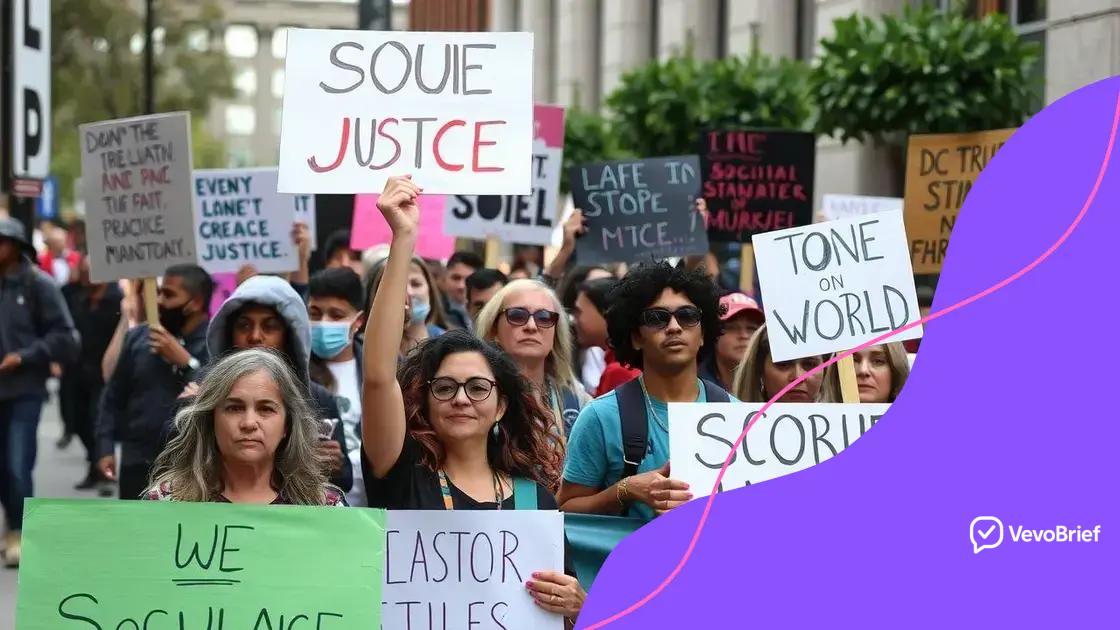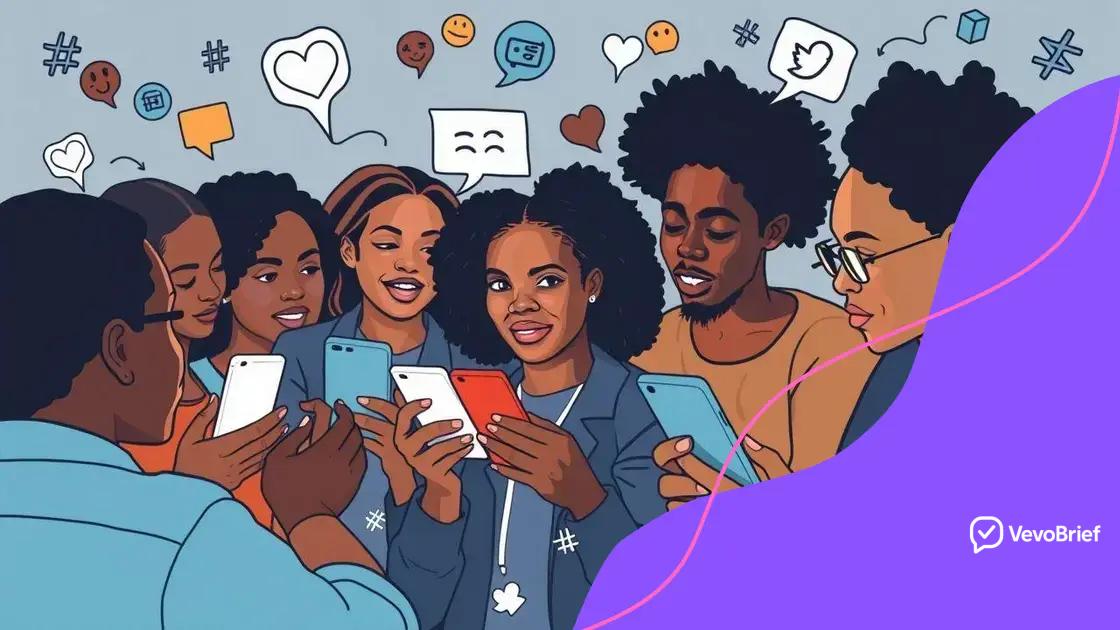Public opinion on social justice: what you need to know

Public opinion on social justice shapes societal norms and influences activism, driving change through awareness of inequalities and the need for equitable treatment across diverse communities.
Public opinion on social justice is evolving rapidly, prompting questions about fairness and equity in our society. Have you ever thought about how your views contribute to the larger conversation? Let’s dive into this pressing issue.
Understanding social justice: definitions and relevance
Understanding social justice is crucial for grasping how societies operate. At its core, social justice refers to the fair distribution of resources, opportunities, and privileges within a society.
It’s essential to recognize the relevance of social justice in our everyday lives. When we consider factors such as race, gender, and economic status, it becomes clear that not everyone has the same access to opportunities. This inequality drives discussions about what justice truly means.
Key Concepts of Social Justice
Defining social justice involves several core components:
- Equity: Ensuring everyone has access to the same opportunities.
- Diversity: Valuing different backgrounds and perspectives in societal discussions.
- Inclusion: Making sure all voices are heard and respected.
These elements work together to promote a fair society. Without them, disparities can widen and lead to conflict. Social justice encourages active participation in addressing these issues.
The Importance of Social Justice Today
In today’s world, the concept of social justice is more relevant than ever. With social movements gaining momentum, people are increasingly aware of injustices that exist within their communities. Fighting for fairness means recognizing historical injustices and actively working to correct them.
Public opinion plays a significant role in shaping the future of social justice. As more individuals advocate for change, the pressure on systems to respond increases. By engaging in conversations about social justice, we can work towards a more equitable and inclusive society.
Historical perspectives on public opinion and social justice
Examining the historical perspectives on public opinion and social justice reveals how societal values have shifted over time. Understanding these changes can help us see why some issues gain attention while others fade away.
For instance, in the 19th century, social justice was largely centered around abolition and labor rights. The fight against slavery highlighted how public opinion can be mobilized to challenge injustice. As awareness grew, more people began to see the importance of equality in various forms.
Key Historical Movements
Several key moments in history shaped our understanding of social justice:
- The Civil Rights Movement: This pivotal movement brought attention to racial inequality and was instrumental in changing laws.
- The Suffrage Movement: This focus on women’s rights changed public perception about gender equality.
- The Labor Movement: Advocating for workers’ rights showed the importance of fair wages and safe working conditions.
These movements illustrate how collective action can change public opinion and lead to significant reforms. The voices of those advocating for social justice create a ripple effect, often inspiring future generations.
In the 20th century, the emergence of global human rights frameworks further influenced public opinion. The Universal Declaration of Human Rights, adopted in 1948, set a precedent for recognizing individual rights and equality.
As we move into the 21st century, technology and social media have transformed how we view social justice. Activism can spread quickly, reaching a wider audience than ever before. Communities can now mobilize almost instantly, highlighting injustices and pushing for change.
The role of social media in shaping justice perceptions

The role of social media in shaping justice perceptions cannot be underestimated. In recent years, platforms like Twitter, Facebook, and Instagram have become powerful tools for advocacy and education regarding social justice issues.
These platforms allow individuals to share their stories and experiences quickly, making it easier to spread awareness about injustices. Social media has made it possible for movements to gain traction in a matter of hours, reaching thousands of people worldwide.
Impact of Social Media on Public Awareness
Social media plays a vital role in public awareness of key social justice issues:
- Real-time updates: Users can receive immediate information about ongoing events and protests.
- Community building: People can connect and organize around shared interests and causes.
- Diverse voices: Platforms amplify marginalized voices that are often overlooked in mainstream media.
As a result, public perception shifts more quickly than ever. For instance, movements like #BlackLivesMatter gained visibility largely due to effective social media campaigns. Through hashtags and viral posts, these movements highlight systemic racism and police brutality, changing how society views these issues.
Additionally, social media encourages conversations around social justice, pushing these topics into everyday discussions. More individuals are interacting with content that challenges their viewpoints, leading to greater understanding and empathy.
However, the nature of social media can sometimes lead to misinformation. Users must be critical of what they read and share. Fact-checking and relying on credible sources are essential to ensure accurate representations of justice issues.
Activism and its impact on public awareness
Activism plays a crucial role in shaping public awareness. It involves individuals and groups advocating for change in society, often focusing on social justice issues. Through various methods, activists bring attention to critical topics that may otherwise remain hidden.
One of the key impacts of activism is its ability to mobilize communities. When people come together for a common cause, they can create significant momentum. This collective effort often results in increased visibility for issues such as climate change, racial equality, and gender rights.
Impactful Methods of Activism
Activists use several methods to raise awareness:
- Protests: Public demonstrations can draw media attention, leading to broader discussions.
- Social media campaigns: Online platforms allow activists to reach a global audience quickly.
- Petition drives: These efforts can gather thousands of signatures to show support for a cause.
Each of these methods plays a significant role in informing the public and influencing opinions. For example, grassroots movements have successfully brought local issues to light, encouraging larger organizations to take action.
Furthermore, activism often leads to important policy changes. When public awareness rises due to activist efforts, lawmakers pay attention. Historical examples, such as the Civil Rights Movement, illustrate how sustained activism can reshape legislation and public policy.
As activism evolves, it continues to adapt to new challenges. Modern movements often blend traditional methods with digital strategies to engage younger audiences. This combination can be vibrant and effective, allowing new voices to contribute to ongoing dialogues about social justice.
Future trends in social justice views
Future trends in social justice views are shaping up to be more inclusive and diverse. As society evolves, people’s perspectives on justice issues are changing, influenced by global events and technological advancements.
One significant trend is the growing importance of intersectionality. People are beginning to understand that social issues do not exist in isolation. Factors such as race, gender, sexuality, and class interconnect, affecting people’s experiences of inequality.
Emerging Voices in Social Justice
The rise of young activists is another vital trend. They are using social media to amplify their messages and reach wider audiences. This generation is vocal about their demands for change, pushing for more accountability and transparency from leaders.
- Increased focus on climate justice
- Stronger advocacy for LGBTQ+ rights
- Emphasis on mental health awareness
These issues reflect a wider understanding of justice that includes environmental sustainability and mental well-being as essential components of a fair society.
Additionally, technology continues to transform how social justice movements operate. Online platforms allow for rapid organization and mobilization. Movements can now spread awareness in real-time, and digital tools help advocate for change effectively.
The future of social justice views will likely include more collaborative efforts across different social movements. As communities come together, there will be a more unified approach to creating equitable solutions for all.
In conclusion, understanding the role of social justice in society is essential for creating a better future. As activism progresses, public awareness continues to grow, driven by new voices and technologies. By recognizing the interconnectedness of different social issues, we can work toward a more inclusive world. Collaboration among various movements will be key to achieving equity for all. As we look ahead, embracing these future trends will guide us in shaping a society that values justice and respect for everyone.
\n\n
| Topic | Details |
|---|---|
| 🌍 Global Impact | Social justice movements have a growing global presence. |
| ✊ New Voices | Young activists are critical in driving social change. |
| 📱 Technology Role | Tech tools help mobilize support and spread awareness quickly. |
| 🤝 Collaboration | Different movements are coming together for a unified approach. |
| 🌱 Future Focus | The future of social justice includes more inclusive practices. |
\n
FAQ – Frequently Asked Questions about Social Justice
What is the main goal of social justice?
The main goal of social justice is to ensure fair treatment and equal opportunities for all individuals, regardless of their background.
How has social media influenced activism?
Social media has amplified activist voices, allowing movements to spread awareness quickly and mobilize support across diverse communities.
What role do young activists play in social justice?
Young activists bring fresh perspectives and enthusiasm, driving change through innovative approaches and digital engagement.
Why is intersectionality important in social justice?
Intersectionality is important because it recognizes that people face multiple forms of discrimination simultaneously, emphasizing the need for inclusive solutions.
